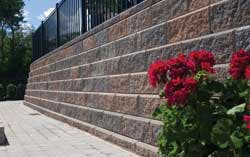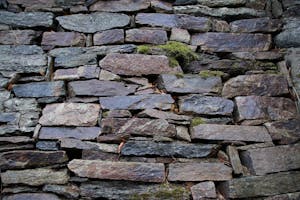Your home’s value can be boosted by adding properly built retaining walls or by upgrading or replacing the current retaining walls on your property. The main elements to consider when building a retaining wall are materials and quality of installation. A properly installed wall will withstand the elements and last for decades. You may be wondering what are the different types of retaining walls? The three main types of retaining walls are concrete, and masonry or stone. The materials you choose will depend on the location of the wall, the aesthetic qualities you prefer, and how long you expect the wall to last.
A retaining wall is used to contain soil and hold it in place in areas where a slope is present. Retaining walls can be used to set off patio and entertainment areas or create paths in residential backyards. Also they can be used to restrain soil in order to form usable roads. Building a retaining wall on your property is no small job, and you want the wall—whether made of concrete, or masonry—to last for as many years as possible. Here are some facts on retaining walls to help you make the best decision for your needs.
Concrete and Masonry Retaining Walls

Poured concrete is the strongest and most durable choice for retaining walls. It may also be carved and formed to look like mortared stone depending on your taste. Poured concrete walls are the only type of retaining wall that aren’t built to be battered (leaned back) against the earth, which is useful if you are short on space.
Interlocking concrete blocks are another alternative—and one which is an easy choice for DIYers. Though made from concrete, the blocks usually have a rough face for a quarried look. They are manufactured to easily fit together without the use of mortar. Masonry retaining walls can be built either with or without mortar and will likely need a mason for proper installation. If they are built properly, they will last upwards of forty years.
Choosing Retaining Wall Materials
When choosing the materials for your new retaining wall, always choose the best quality material you can afford — the better the materials, the longer the wall will last (and the safer it will be as well). Remember that a retaining wall is meant to hold back tons of soil, so be sure to only use top-quality material. If your retaining wall will be more than 3 feet high, you are also obligated to use an engineer and you may also need a permit. Aesthetics will play a big role in your choice of material. For instance, if you want a modern, sleek feel to the wall, opt for poured concrete rather than stone.
Anatomy of a Retaining Wall
Each retaining-wall material has its needs in terms of space, labor, and installation expertise. The requirements of each type of retaining wall are detailed below. It is important that retaining walls are installed properly to get the longest life from them.
Masonry Retaining Walls

For a masonry retaining wall, it’s best to get a professional mason to install the wall. The footing must be placed below the frost line and should be made from rebar reinforced concrete (a steel bar or mesh of steel wires is embedded within the concrete to strengthen it). Weep holes (small holes that help the water to drain water away from the wall) must also be utilized every 6 to 8 feet. Mortar-free walls, however, only need a crushed-stone footing rather than a reinforced-concrete footing. A batter of 1 inch per 1 foot of wall should be added.
Poured Concrete Retaining Walls

A professional must construct your poured concrete retaining wall. Like the masonry wall, the poured concrete wall also needs a reinforced concrete footing and weep holes every 6 to 8 feet. However, poured concrete retaining walls do not need a batter.
Interlacing Concrete Block Retaining Walls
A retaining wall constructed of interlacing concrete blocks requires a simple crushed-stone footing. Heavy-duty mesh anchors every other course against the ground, and it also has a batter of 1 inch per 1 foot of wall.
When a Retaining Wall Needs to be Replaced

Although retaining walls can last for decades, there does come a time when they need to be replaced. If you see any of the following signs, it’s time to start planning a replacement wall as the building material has been compromised:
- Leaning — Usually caused by tree roots, poor drainage, or a failed footing
- Cracking — Small cracks may be filled in, but cracks more than a quarter inch wide and deep and more than 2 feet long are signs of structural damage
- Sagging — Sagging is a sign that the footing has failed at a specific spot. A professional may be able to rebuild the affected section of the wall, but depending on the extent of the failure, the whole wall may need to be replaced
- Bulging — Bulging is a sign of a buildup of water pressure behind the wall, or a lack of anchoring in the case of interlocking blocks. Careful excavation may save the wall, but it may need to be rebuilt.
At Fizzano Brothers, we pride ourselves on being a few steps ahead of the competition. Because we are a family-owned and operated business, we understand that our customers are our top priority. And because all we do is masonry, we ensure that every member of our team knows our products and how to advise you based on your needs and tastes.
Our selection and customer service simply cannot be matched by the big-box retailers. Contact Fizzano Brothers when you’re considering any project that involves masonry, including patios, walkways, facades, or retaining walls. We’d be thrilled to help you get started!

